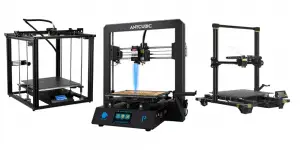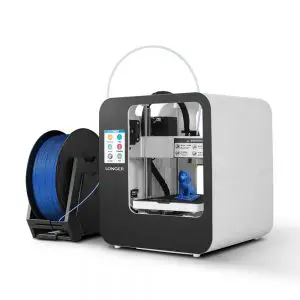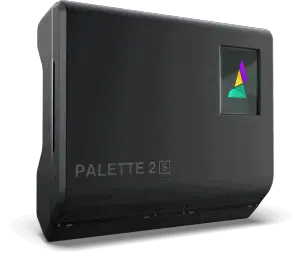If you’re in a hurry and just want to know what the best ABS filament is then, we recommend Hatchbox ABS as the best one.
PLA and ABS are certainly the most popular filaments in 3D printing. While you should never limit your creativity to one type of filament, each type has its place. Perhaps your project calls for a material slightly more durable that can withstand higher temperatures. This is where ABS filaments come into play. When it comes to the best ABS filament, there are a few to choose from but it’s important to know what you’re looking for.
In this article, we will be reviewing the following ABS 3D printer filaments:
What Is ABS 3D Printer Filament?
Acrylonitrile Butadiene Styrene, better known as ABS, took just over a decade to become the most popular engineering polymer. Styrene reinforced the Acrylonitrile to make it tougher while the Butadiene lends the chemical compound its rubber properties. The resulting petroleum-based plastic is easy to process through machining techniques like sawing, milling, shearing, die-cutting and drilling. It has a yellow tint in its natural uncolored state and is typically delivered in pellets prior to being processed into filament.
ABS Filament 3D Printing: What Can It Do?
The filament melts and cools without changing its chemical properties making it optimal for use in 3D printers. Some companies developed printers specifically for the material.
Here are a few reasons to consider using ABS:
- During the post-build process, ABS 3D printer filament allows makers to glue parts, file off material, use acetone and it’s easily painted with acrylic colors.
- As long as you get the proper settings with temperature management correct, you can get great results.
- Its mechanical properties allow for durability, stretch and high endurance to heat with resistance to everyday chemicals.
A few of the filament’s drawbacks come when printing outdoors where ABS can sustain damage from direct sunlight. Trying to cool it can cause cracks or splits between the layers if the temperature isn’t brought down slowly. Curling and warping can occur when printing projects with a broad base. Last, but not least, it stinks. Burning off ABS during the build process releases a plastic smell. It’s not toxic unless burned at temperatures of 400 degrees Celsius and higher because the material decomposes into its original components of styrene and butadiene which can be carcinogenic to humans. The odor is known to Be sure to print in a well-ventilated area.
Another unfortunate drawback is its lack of sustainability. It’s not biodegradable nor is it made from renewable resources. It’s also not safe for food, so do not print anything you’d eat or drink from with the filament.
However, here are a few creative builds you can create with ABS filament:
- Print cases or project enclosures to put your creations on display or as a space for post-processing to finish
- Toys or action figures like Lego bricks and fidget spinners are easily created and built to last
- You’re able to create automotive hardware or parts the can be hard to find, expensive when you do find them, or difficult to replicate with the vehicle’s original materials
To get these builds in their best possible condition, you need the following basic settings:
- Print bed temperatures should reach 95 to 110 degrees Celsius, they should be heated and an enclosed print area is best for ABS
- If the adhesion of your print bed isn’t suitable for ABS, use tape, ABS slurry, or some other adhesive to help your builds stick to the bed and avoid a failed print
- A special hot-end isn’t required for printing with the material, but the temperature should be set between 220 to 250 degrees Celsius
- A part cooling fan isn’t required but the temperature of the enclosed print area or the environment needs to be ambient enough to avoid warping, curling or cracking of the build. ABS is finicky while printing where the temperature can’t be too hot or too cold.
So which brand handles these qualifications the best?
Searching For The Best ABS 3D Printer Filament
Hatchbox ABS
Builds are durable with high quality. Hatchbox offers a 30-day moneyback guarantee. This filament prints with a glossy finish and requires less post-processing.
- Colors available: Black, Blue, Green, Gold, Orange, Purple, Neon Green, Silver, White, Yellow, Glow-in-the-dark, Transparent Clear
- Dimensional accuracy: +/- 0.03mm
- Net weight: 1 kg spool
- Print speed: 60 mm per second
- Extruder temperature: 210 degrees Celsius – 240 degrees Celsius
- Bed temperature: 55 degrees Celsius to 85 degrees Celsius
- Diameter: 1.75 mm
Pros:
- This filament is an inexpensive alternative to more expensive ABS spools
- Reliable dimensional accuracy allows for smoother finished builds
- There’s good layer adhesion, but may require additional adhesive materials for the print bed
- The recommended print settings are on the packaging of the spool
- There’s a long shelf-life if stored at ambient temperatures
Cons:
- Using acetone vapor for post-process smoothing can cause warping
- Quality of the filaments can change based on the supplier purchased from
- Improper storing of the product, which can be as subtle as shifting degrees in environment temperature, can render the filament unusable and stiff
No products found.
There is a one-year warranty available and if there are any quality problems with their 3D printer filament they will give you a solution within 24 hours of receiving your complaint.
No products found.
- Colors available: Black, Grey, Blue, Green, Red, Transparent, White,
- Print Speed: up to 90 mm per sec
- Dimensional accuracy: +/- 0.02 mm
- Net weight: 1 kg spool
- Extruder temperature: 220 degrees Celsius – 240 degrees Celsius
- Bed temperature: 90 degrees Celsius to 110 degrees Celsius
- Diameter: 1.75 mm
Pros:
- There is high durability and low odors with this brand
- The filament’s fairly priced
- It’s compatible with a large variety of 3d printers and pens
- There’s high purity with low shrinkage
Cons:
- Be sure to check the packaging as some users have reported receiving PLA instead of ABS, so there are some quality control issues with the suppliers
- Some users reported clogging and filament becoming very brittle
IC3D ABS
There’s a 30-day refund window should you find any issues with the filament. Its mid-ranged pricing keeps it affordable with slightly higher quality and little post-processing.
- Colors available: Black, Blue, Green, Orange, Yellow, White, Beige, Grey, Red
- Print speed: 30 mm per sec
- Dimensional accuracy: +/- 0.05 mm
- Net weight: 1 kg spool
- Extruder temperature: 220 degrees Celsius to 230 degrees Celsius
- Bed temperature: 90 degrees Celsius to 110 degrees Celsius
- Diameter: 1.75 mm
Pros:
- Easy to glue post-process and sanding is very minimal if at all
- There’s low odor with an enclosed build area
- It has very good layer adhesion
Cons:
- The spool is lightly larger than the average filament roll so it doesn’t always fit in the printer’s spool holder/compartment
- The first layer doesn’t stick very well
- Some users report poor filament quality and warping
No products found.
Inland ABS boasts to be made for compatibility across multiple 3D printers and pens that allow you to spend less time troubleshooting and more time creating builds.
No products found.
No products found.
- Colors available: Black, White, Gray, Luminous, Orange, Light Blue, Blue, Green, Silver, Natural, Red, Yellow
- Print Speed: 100 mm per sec
- Dimensional accuracy: +/- 0.05 mm
- Net weight: 1 kg spool
- Extruder temperature: 240 degrees to 260 degrees Celsius
- Bed temperature: 80 degrees Celsius to 100 degrees Celsius
- Diameter: 1.75 mm
Pros:
- This filament’s hard and strong with some flexibility
- Finished builds are soluble with acetone and easily sanded
- You receive good quality for the price
Cons:
- Quality control issues with some users receiving filament with moisture that causes clogging and bubbling
- Impurities reported from some users and bad adhesion between layers
No products found.
While there isn’t any specific warranty information, most suppliers offer a 30-day refund or exchange policy with this filament brand. High-quality builds can be produced with this filament with less of the plastic burning smell.
No products found.
- Colors available: White, Silver, Red, Blue, Black, Natural, Yellow, Orange, Pink, Luminous Green, Grey, Purple, Light Blue, Peak Green
- Print Speed: 220 degrees Celsius to 260 degrees Celsius
- Dimensional accuracy: +/- 0.05 mm
- Net weight: 1 kg spool
- Extruder temperature: 220 degrees Celsius to 240 degrees Celsius
- Bed temperature: 80 degrees Celsius to 100 degrees Celsius
- Diameter: 1.75 mm
Pros:
- Users report a low odor during printing
- Great quality for the price, especially after finding the best specs and settings for your printer (Tinkering with the settings and the amount of time spent on it truly depends on the type of printer you’re using with ABS filament)
- Consistent quality across the brand and colors
Cons:
- Users have reported the spool unraveling and causing tangles which cause unsupervised builds to fail
- Some users had quality control issues where the spool they received contained moisture
- Users have reported broken filaments and clogging
Which Is The Best ABS Filament?
Overall, Hatchbox ABS can be touted as the best ABS 3D printer filament because of its dimensional accuracy, color availability, lack of tangling, price and easy to use right out of the box. Users often have a split reaction when it comes to ABS filaments. Once they try it, it tends to be the best builds they’ve ever created or the worst. Either way, when experimenting with ABS, try using a sample roll to print some test prints with your printer to work out the kinks and find the best settings.
Last update on 2025-06-07 / Affiliate links / Images from Amazon Product Advertising API








